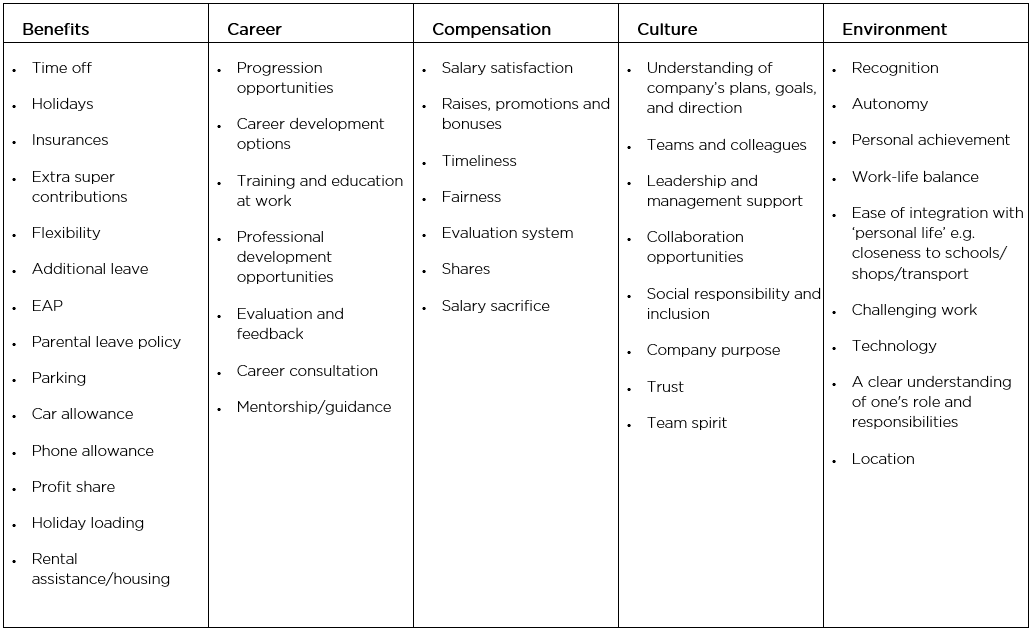
Updated May 2024:
At Kinexus we speak to a lot of businesses about their employees, their hiring intentions and their workforce needs. We often get asked about employer brand and Employee Value Proposition (EVP), specifically about what other businesses and the industry are doing to attract and retain workers in this candidate short market.
Savvy companies have recognised that without a solid employer brand and EVP offering, it’s increasingly difficult to attract and retain the best workers.
With a good employer brand and EVP behind you, your business stands out from the crowd and talks directly to the highest quality candidates. Without one, your business might seem generic or purposeless.
In this blog we’ll discover what the differences are between employer brand and EVP, how they play out in defence industry and how to use your employer brand and EVP to position your business as an employer of choice.
The differences between employer brand and EVP
Firstly let’s take a look at the difference between employer brand and EVP and how they play together to promote your business to current and potential team members.
.jpg)
Employer brand
Employer brand encapsulates the entirety of the employment experience. It describes an employer's reputation as a place to work, both intentional and unintentional, and refers to how a prospective employee would perceive the company’s values and work environment. This unique identity should be authentic and purposeful.
The employer brand is distinct from a more general corporate brand reputation.
Elements of Employer Brand

Employer Value Proposition (EVP)
EVP is a part of employer branding as it seeks to identify and communicate the unique benefits of working for an organisation. These benefits might be both tangible and intangible, including company values and culture, as well as the rewards and opportunities on offer.
EVP is what your employees can expect to get in return for working for you. It can be helpful to frame EVP as an employee WIIFM (What's In It For Me)?
A robust EVP plays an important role in a company’s attraction strategy and contributes to staff retention in a competitive job market.
EVP offers a separate value proposition to what a company might offer its customers.
Elements of Employer Value Proposition
.jpg)
What this looks like in defence industry
Types of EVP on offer in defence industry organisations:

From data captured in our latest Defence Industry Insights report we can identify what benefits are being offered by defence industry employers. Respondents were asked to select all benefits that applied to them. Percentages represent the proportion of respondents that receive each additional benefit.

How to use your employer brand and EVP to position your business as an employer of choice
Although both are separate concepts with strategies, employer brand and EVP certainly overlap. It’s important to develop robust strategies for both in order to give your business the best chance of attracting and retaining the best talent in your organisation.
Once effective employer brand and EVP strategies have been developed, the next step is communicating these things effectively to internal and prospective employees. As an attraction strategy, effectively promoting your employer brand and EVP will position your organisation as a stand-out employer and ensure that you attract employees of the best cultural fit. As a retention strategy, the promotion will keep employees engaged, purposeful and motivated.
15 ways to incorporate your employee brand and EVP into your attraction and retention strategy:
Add clear EVP benefits to all job descriptions
Mention company values in interviews
Share your EVP on social media
Create a LinkedIn career page to tell your story and highlight company benefits
Express values and brand through website and blog content
Include elements of your employer brand in communication with potential candidates
Reiterate in internal lectures, training and workshops
Incorporate throughout the application process
Include in any company guides, contracts, or induction documentation
Create a company Glassdoor page
Showcase, promote and celebrate awards
Pursue and share company reviews and testimonials
Use social media to engage with the community, not just distribute content
Create ‘life at’ videos, photos and content to share in job adverts, through the application process and on your website.
Ensure all your communication with candidates eg. job descriptions, career pages, email communications, application portals and social media, is aligned with your company branding.
Trust and reputation are built through consistent messaging. Once you have developed, implemented and promoted your company’s employer brand and EVP, make sure you showcase it at every opportunity. As your company profile grows and more candidates hear your story, your desirability as an employer will increase.
About Kinexus
Kinexus supports defence industry nationally, both through permanent and contract recruitment, and through providing workforce insights, market mapping and other HR services. Looking for work and interested in exploring opportunities in defence industry? Get in touch with our teamor take a look at our open vacancies.
Photo by krakenimages on Unsplash





